by Bill Murray
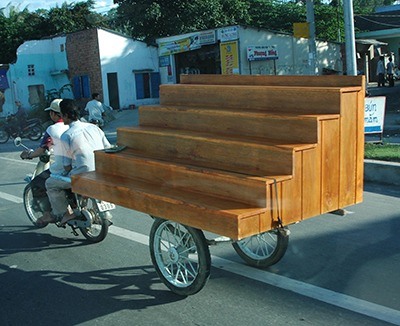
OUTBOUND
We’re off to meet a small live-aboard motorboat about three hours drive south of Ho Chi Minh City to cruise the Mekong Delta for a few days. The older gentleman driving has a deep, rich voice we don’t understand, speaks no English and we no Vietnamese besides pleasantries, the names of some food and a particular local beer, 333, not very challengingly pronounced baa baa baa, like the black sheep.
He’s a pro driver, no doubt about that, all turned out in a nice golf shirt and slacks, and he works our little sedan to the Saigon River then south out of town, and holds a steady course until the city falls away. He appropriates the left lane and proceeds with zealous caution, a campaign strategy he follows every bloody deliberate inch of the way.
Steady ahead. If he hurtles inadvertently to 60 kph, even on long, empty stretches, his face flushes and he brakes abruptly. Could he be working by the hour? If they say this trip should take three and a half hours, no way will he make it three hours and a quarter.
We first came to Saigon twenty-five years ago. Since then women have largely dispensed with the demure way they rode the back of cycles, both legs to one side. Back then many more women wore the traditional Ao Dai, the thin, body length robe. Perhaps that made it hard to sit any other way.
The river yields to a web of canals. Smart electronic overhead signs show the way through less kempt industrial outskirts. Now we roll along a divided six-lane highway, with extra outside lanes for every variety of two-wheeler, and this goes on for miles and undifferentiated miles.
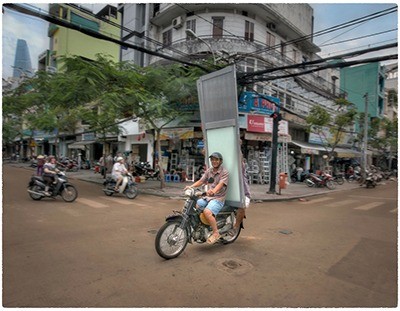
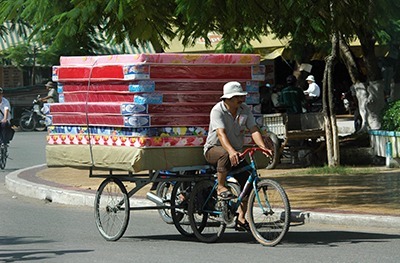 A motorcycle chugs by pulling a cart jammed with coconuts. A young man with sheaves of office paperwork on his lap angles off to the right. A man riding pillion holds an eight rung bamboo ladder. It sticks out past the front of the scooter over the driver. That can’t be comfortable. Trash collectors pedal along, riding the wrong way against traffic with collapsed cardboard boxes tied to the back of their bicycles. You’re apt to see most anything.
A motorcycle chugs by pulling a cart jammed with coconuts. A young man with sheaves of office paperwork on his lap angles off to the right. A man riding pillion holds an eight rung bamboo ladder. It sticks out past the front of the scooter over the driver. That can’t be comfortable. Trash collectors pedal along, riding the wrong way against traffic with collapsed cardboard boxes tied to the back of their bicycles. You’re apt to see most anything.
The general strategy for turning left doesn’t vary a lot in the grand turn of the wheel from rural China to south Asia: If you brazen your way to block oncoming traffic fast enough, just impose your vehicle on everyone else’s forward progress, you present a fait accompli: I now own the highway before you. You have no choice but to brake for me, and every intrepid co-conspirator who attaches his fate to mine.
A dense collection of replacement radiators hopes against hope beside a raft of shops selling chest-high electric fans. Here is a brickyard. Fruit and vegetable carts. Canals run every which way now, sometimes alongside fields grown wild, sometimes through wetlands, sometimes where traffic and bustle and dump trucks close in, menacing. A sudden frenzy of monster two-tier tour buses swoops and squeezes mere sedans and Vespas to the verge.
Photocopy! Baguettes! Furniture! Headboards! Identical bureaus in a sequence of storefronts. Dried fowl hanging behind glass in rolling carts along the roadside. A proper meat market.
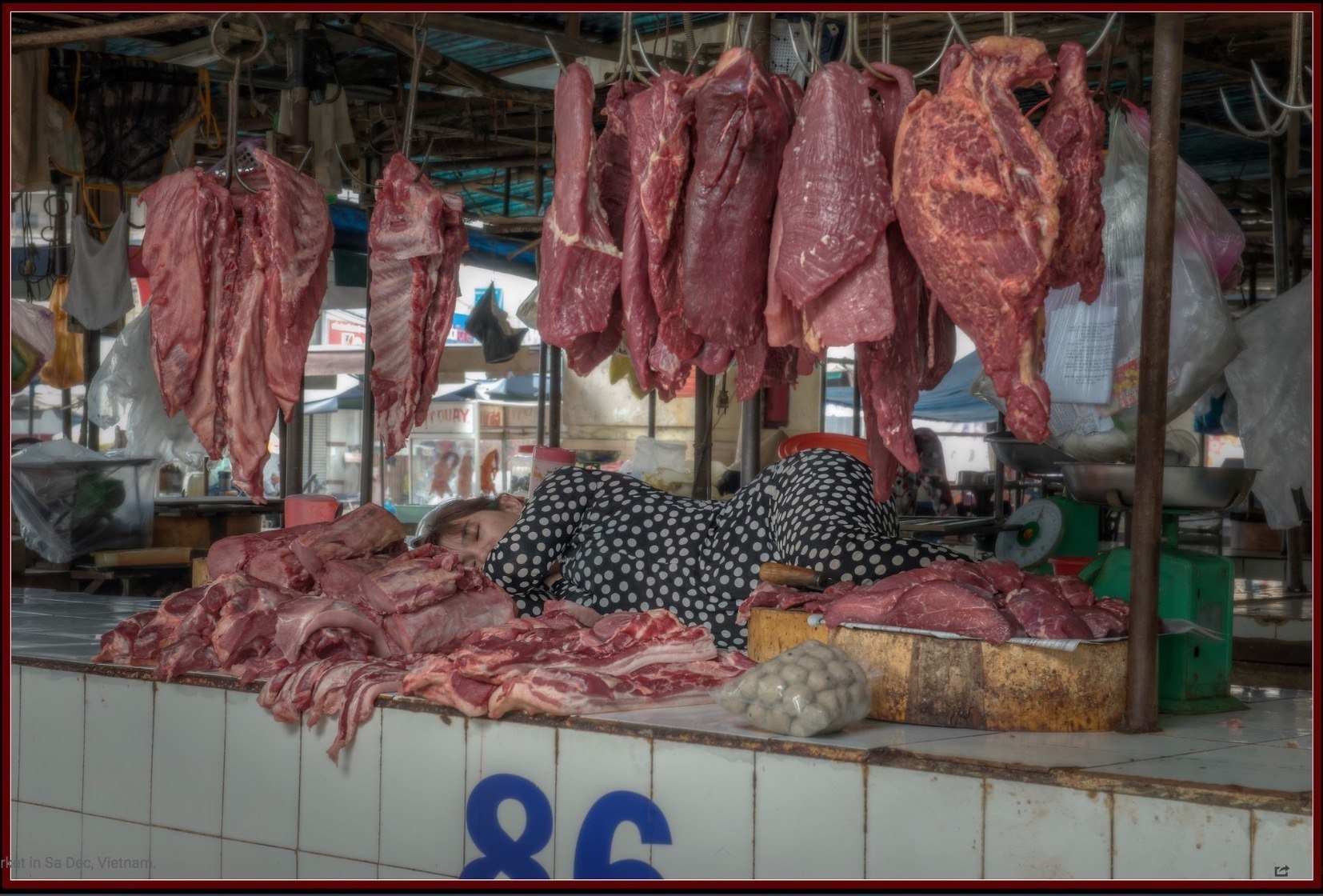
A most unlikely place for the Mercedes Benz Haxaco dealership, seems to me, beside a collection of rebar warehouses with roofs of corrugated metal. I am not sure why, but here is an empty, outdoor lot full of dozens of mannequins dressed in ladies clothes, followed by a tended-green-space flyby, and the “584 Group,” a cluster of high-rises set back off the road.
Billboards announce copper, aluminum and plastics manufacturers, functioning industrial estates, others marked out for the future. Vietnam is hurtling pell mell through its Deng Xiaoping “to get rich is glorious” period.
With GDP growth more than five per cent year-on-year each of the last seven, living standards in Ho Chi Minh City’s District 1 skyrocket while environmental best practices are trampled on the stampede to financial glory. Ask about recycling the plastic water bottles that keep you alive and well (the government being unable to deliver drinkable water by pipe) and receive a look of dull incomprehension.
Here Vietnam can take solace from 1980s Japan, aspiring then, but now as gloriously rich as anyone. Alan Booth walked the length of Japan in the 80s and wrote about it in The Roads to Sata.
“Japanese is a very adequate language for complimenting the autumn moon and things like that, but it is sadly deficient in words for expressing a less harmonious relationship with nature…. The piles of beer cans and broken bottles that Japanese visitors (to tourist sites) seem not to see. It is a marvelous gift, the ability to treat the inconvenient as though it wasn’t there.”
Ditto Vietnam.
It is not clear that boats could navigate canals among all the invasive, surface-floating plants. The plant botanists call eichhornia crassipes, known to everyone else as water hyacinth, thrives in dirty water and it has come to the right place. A delicious, ubiquitous and approximately free side dish in restaurants is “morning glory,” or water spinach, and one wonders with some trepidation where it grows.
A cycle shop puts a hundred stylin’ helmets in its show window. Next door a restaurant offers just as many seats. Roadhouses beckon you in to plastic tables and chairs to enjoy your lunch beside, likely as not, a welders’ arcing firing next door, or a floor tile showroom.
Every hundred meters banh mi carts hawk street food. Restaurants that serve a variety of foods are for tourists. Vietnamese folks eat at a pho restaurant for pho, a banh mi cart for banh mi and so on.
Roadhouses advertise repetitive fare centered around these two dishes, but there is more:
banh canh: a thick noodle from tapioca flour or a mixture of rice and tapioca flour.
heo quay: a crispy roast pork
hu tiu: clear noodle soup with pork and/or shrimp
bun rieu: meat, rice vermicelli soup
com phan: a prix-fixe set menu family meal.
I will never reconcile the sanguinity of women, men and boys eating noodles in places like this on low plastic stools scarcely a modest stride from the highway. Once you’ve enjoyed your pho without being plowed under by a dump truck, though, you can celebrate in a roadhouse hammock, strung side by side in rows, for a post-prandial siesta.
•••••
Unlike his Chinese neighbor, the Vietnamese schoolchild need not memorize the 3000-odd characters required to read a newspaper, and for that evangelizing missionaries deserve credit. Jesuits from Portugal, Germany, Italy, Spain and at least one Frenchman set up shop in Tonkin, as northern Vietnam was then known, in the late 1500s.
The French Jesuit Alexandre de Rhodes gets popular credit for chữ Quốc ngữ’, the Vietnamese “national language script,” but a professor of Asian languages contends that use of Portuguese orthography in early texts is a “dead giveaway that the true pioneers of the script were not French.”
Whatever chữ Quốc ngữ’s origin, now comes its inevitable Englishizing. After enough Ca Fes and Ca Phes and Cà Phês for coffee, I wonder if Shop Ti Ni is a tongue in cheek ‘little shop,’ which, it turns out, is exactly what it is. So I suspect ‘Mai Man’ is posing as English-cool.
•••••
In 2015‘s Asia’s Cauldron, Robert D. Kaplan puts all kinds of Vietnamese government heavy-handedness down to officials’ education in the former eastern bloc, producing engineers with “an institutional preference for dams, tunnels, freeways and vast power lines….”
And before us rises a behemoth, the Can Tho bridge, looming high above the Bassac River, the Mekong’s biggest channel to the sea. Reasonably new (2010) and expensive (US$342.6 million), it stretches 2.75 kilometers. A 90-meter approach ramp collapsed during construction killing a disputed number of workers, at least fifty. It replaced a network of ferries.
South of the bridge banana trees and their tropical fruited kin grow hard by the road and women work the verge peddling from don ganhs, those shoulder poles, metaphors for motherly love. Vending dual baskets of fruit or flowers or ceramics or who knows what, mama literally shoulders the burden of breadwinner.
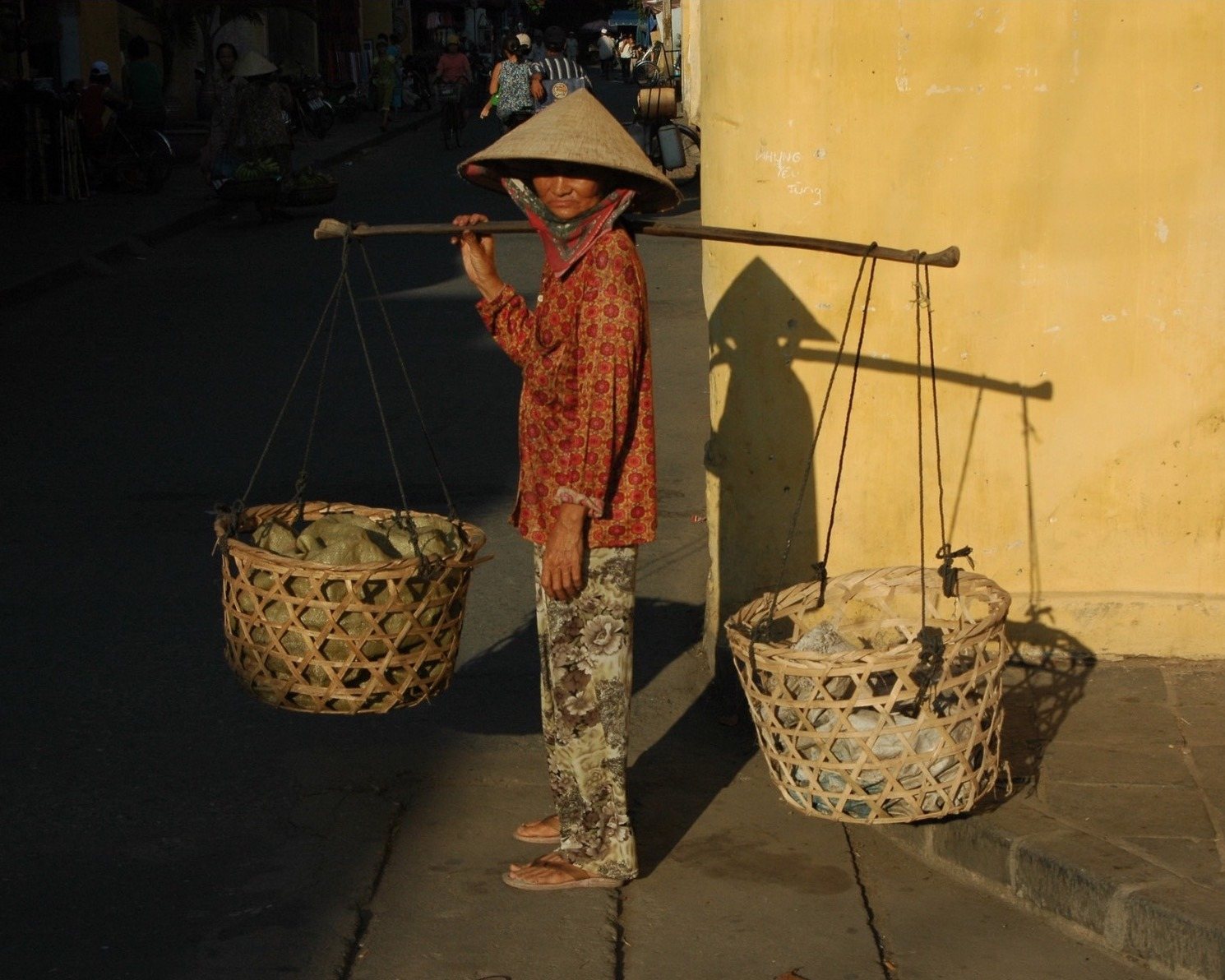
We slam to a sudden complete stop for a mother hen and her four chicks, wee babies. Mama has fluttered out of the way of an oncoming car, the chicks are stranded on the wrong side and all of the Mekong Delta, at least the whole of this highway, comes full stop until the family is reunited.
A billboard welcomes us to Sa Dec City, where dead stops render traffic immobile through cycles of traffic lights. Cops with little blue and white police sticks harass drivers, who can’t flee. Our driver celebrates our arrival by freeing himself from his seat belt. For some relaxed, safe city driving, I guess.
It looks like we’ve found where we’re going. We wait behind a produce truck taking on cargo with Amazon warehouse efficiency. Eggplants, cucumbers, cabbages and potatoes are loaded in, bags filled to bursting. The red onion man cycles up, throws on two bags, cycles off. The ginger man rides up on a scooter and places three see-through bags on the ground at the back of the truck. He toots his little horn as he drives away, summoning the truck’s packing boy from a plastic chair down by the river, who packs them in.
Across the street, two boys heave bags of rice, each as big as they are, one on top of the other. A very young woman tugs and tussles and drags the top two right back off the stack and sideways onto the ground, opens and rolls back the tops and begins to weigh out smaller bags on a little green scale.

Our driver has been on the phone. As soon as he stopped behind the produce truck he flipped on his blinkers and made two calls. In between, an incoming call. Another call placed. A team effort, a tourism squadron working on finding our boat. Fifteen minutes.
A team of rice baggers in non las, those round, pointy hats, gets a production line going in the store across the street. In minutes a dozen and a half smaller bags are for sale.
We drive off, nothing seems to prompt it. The driver takes another call and we turn around and park in the same place on the other side of the street. Another incoming call and we find that our ship has been anchored a block away the whole while, just blocked from view by all the activity of the market.
INBOUND
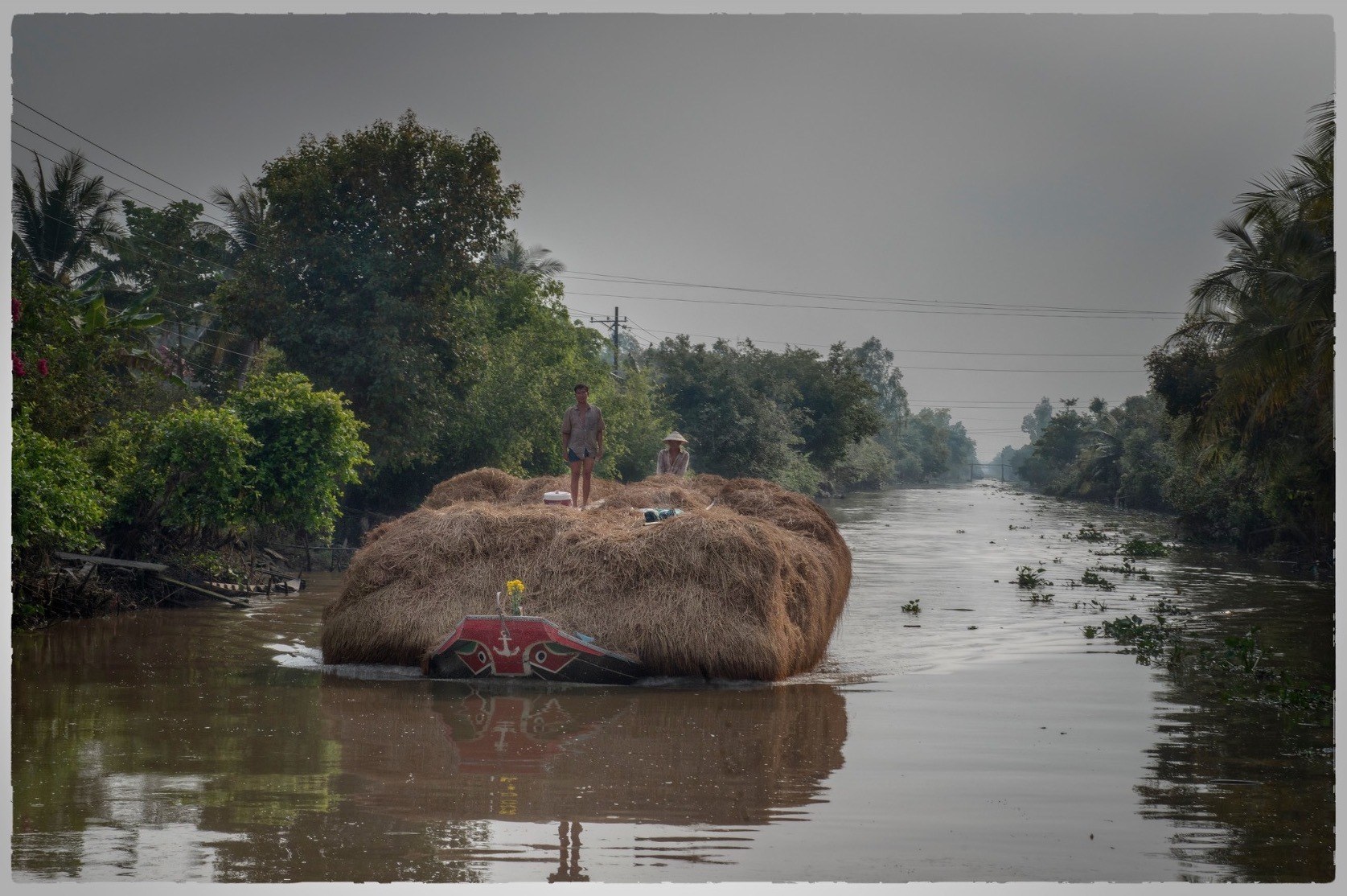
Out on the water after noisy roads, silence was the music we yearned to hear, a three day minimalist symphony of lolling water against the hull. Today we have spent the day in the border town of Chau Doc watching cigarette smuggling. It takes seconds, not half a minute for boats to hurtle from Cambodia just tens of meters to waterfront Vietnamese warehouses, their doors opened only briefly, the boats leaving no more than a vague, dissipating wake.
Now our longtail-fitted Mercruiser’s motor screams as we hurtle down backwater canals returning to Ho Chi Minh City. The ship seats sixteen but we are the only ones on it, with a staff of two, their heads back on their seats, mouths open, sleeping in the wet air, my wife too. Just the driver and me watching the river go by. The rains have come, forcing the windows closed and attention to the inside, making sleep the preferred onboard activity. Anticipating the rains, running with the windows open and grey nimbus roiling the sky, the anticipation of atmospheric mayhem exhilarates (There is putative science here).
Just now we’re flying, meaning to make 240 kilometers in five or six hours, fairly gliding over a straight-as-the-captain-of-the-debate-club man-made canal. Commerce drops away between villages but there are stilt houses almost everywhere, fish traps and giant bamboo looming twenty meters out of the water, catfish below.
When a transport passes, one with big red eyes painted on the bow, its wake slams the bottom of our boat. The crew sleeps through it; they only wake if we slow, sensing something may be wrong. Nothing ever is.
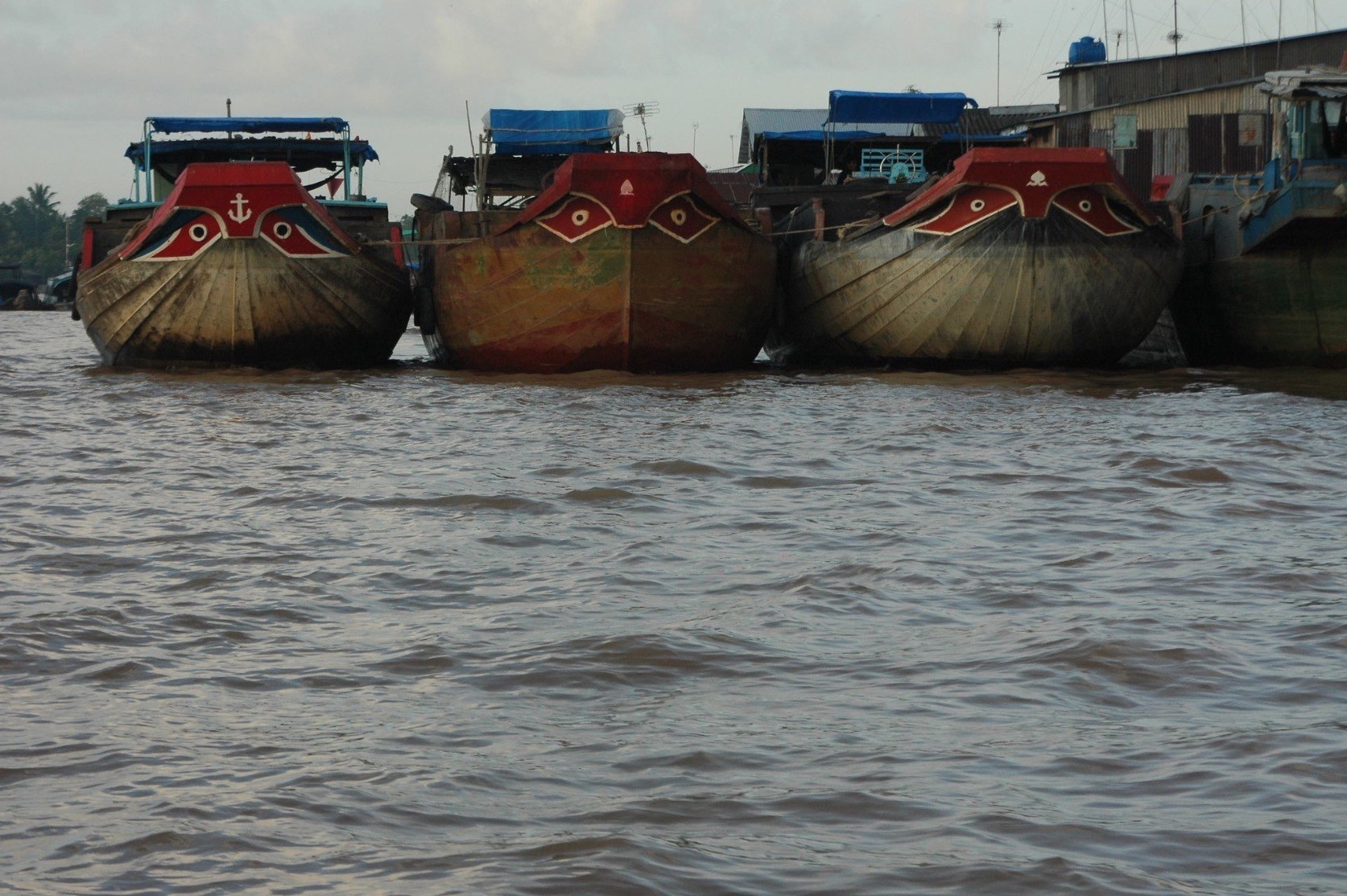
We might slow to avoid capsizing a smaller longtail with fishermen and their nets, or to pass through a water-facing village. Twice, then three times, we stop to reverse the engine to purge water hyacinth strangling the blades.
I’ve cracked the window open to watch the way rain affects river life. The forward movement of the boat pushes the rain away. Non la hats shelter pilots of the smaller boats from the rain; they stand in the downpour, steering foot on rudder.
Life goes on onshore. Timber waits to be loaded. The man at the brick warehouse eats a bowl of lunch. Another man stands by water’s edge in business dress, white shirt and black slacks, not near houses or anything else, alone in the rain.
Village kids have all come out to play in the rain in the river. Mama washes dishes under thatch at the back of the house with more kids in the doorway. I look at them and they look back as we speed past on our way to Saigon.
•••••
There are 488 more photos in the Vietnam Gallery at EarthPhotos.com.
